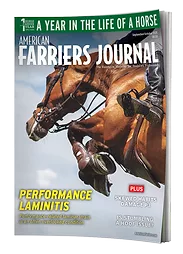Hermon, N.Y., farrier Bill Balling’s road to shoeing wasn’t straightforward, but he tells North Country Public Radio (NCPR) that he would “absolutely” do it again.
Balling looked back at the path to his career, which started in 1979 when he moved from New Jersey to Northern New York, for NCPR’s “North Country At Work” series.
He explains that he moved in search of cheap land — for which the St. Lawrence Valley was a hotspot — and calls himself a “late back-to-lander.”
“Looked at land in the south, and we got stuck in a snowstorm in a field in Kentucky and I decided I didn’t like it,” he says. “My second choice was New York state for cheap land, and the farther north I traveled, the cheaper the land got, and I ended up here.”
At the time, he was 31 and had no experience in living off the land, but he wanted to work with draft animals and get closer to nature. So he started working with another back-to-lander and his oxen before moving on to Belgian draft horses.
Thus, Balling started shoeing out of necessity. The horses hauled wood and performed tasks for local farmers throughout the winter, and they needed better traction for the icy conditions.
“Turned out there was no one in the area that made those shoes,” he says.
He went through three men to get generic shoes modified and onto his horse’s feet.
“I had to find a person to shape the shoes — that was Eli Tracy. I had to find another person to put the hard surface material on, and Leo Rasley, who lives over in the Macomb area — he actually nailed the shoes on the horses for me.”
The ordeal he had to go through to get his horses shod made him look into shoeing as a career.
Balling attended the Green Mountain Shoeing School in Woodstock, Vt., and brought his skills back to the Hermon area. It was an underserved area where many horse owners couldn’t afford farrier work.
So he charged half of what others in the area charged.
“I kept my prices low so that folks that normally wouldn’t have been able to afford to have the work done could have their animals taken care of,” he says. “But I made enough up here to get by. Quite a few horses I worked on up here were horses that needed to work.
He loved the work.
“This kind of work … I have to be in contact with the horse all the time. So I was either leaning against the horse with my side or my back. You had to be able to read the horse,” he explains. “If it decides it wants to do something you don’t want it to do, you can generally feel the movement of the horse first before it reacts, whether it’s a jump or a kick or a quick movement.
“I would be able to feel the tenseness of the body or a muscle tightening … I enjoyed it.”
Many owners had been taking care of their own horses’ hooves — or trying to — before he got to them.
“And they’d have a rusty old rasp that might’ve been good for woodworking, and a pair of nippers were invariably nail clippers, and when I saw nail, I mean the actual horseshoe nail,” Balling says.
He would travel within 50 miles of Hermon to take care of draft and saddle horses. Occasionally, he also worked with the Amish communities on corrective shoeing issues or if he needed specific shoes.
“I was good friends with two or three or them [Amish farriers] — if I needed a type of horseshoe I didn’t have, I would take a drive over to their shops to see what was available.”
He retired in December 2017, having spent nearly 35 years as a farrier. He didn’t want to stop, but the work took a toll on his body.
“I did it anyway… I don’t know if I showed them or they showed me!”






